Abstract
The Software Engineering program at Fairfield University offers multiple service learning courses to provide opportunities for students to apply learning in the classroom to real world problems and to understand the nature of societal challenges as responsible citizens in a community. Various software projects have been developed at Fairfield University and provided to community partners. However, follow-up studies measuring the impact of these projects to the community have not been properly conducted after the delivery of the software products. In 2010, the students in the Software Capstone Project course redesigned the website for Hispanos Unidos, Inc., a non-profit Latino organization whose mission is to educate and prevent HIV/AIDS. After the successful deployment of the newly designed website with search engine optimization features, the impact of this service learning project was measured by collecting usability data, survey data, and Google Analytics data. The results showed:
(1) a high acceptance rate of 4.5/5.0 determined by a usability test, (2) 67% of survey participants reported a “Big Improvement” and 32% reported a “Moderate Improvement” in the website overall, and (3) significant increase in the visibility of the site to the community including a 40% increase in the number of visitors as measured by Google analytics. This article discusses the process and outcomes of this project.
Introduction
The Software Engineering program at Fairfield University has integrated a service learning component into its curriculum to expose software engineering students to the community-engaged scholarship learning model and to provide service to community organizations which are in great need of quality software applications to facilitate their work (Hatcher & Robert, 1997). Due to limited budget and lack of expertise, many non-profit and social service organizations enter into community functions without solving their problems in technology.
The service learning model also reflects the university’s mission of integrating living and learning. Through reflection and results from student surveys, we have continuously noticed the benefit of the service learning courses and projects to students’ growth (Adler-Kassner, 2000). Several courses have been designated as service learning courses by the Office of Service Learning at Fairfield University. The Capstone Project course offered in the Software Engineering program was the first of those designated service learning courses in the School of Engineering in 2009. Later, more software engineering courses became service learning courses and various software projects have been successfully delivered to our community partners for the past several years (Rusu & Lawlor, 2010). The Capstone Project course is a two-semester team project course covering the entire software development lifecycle: requirements gathering, requirements analysis, design, prototyping, implementation, testing, deployment, and maintenance.
Students in the class are typically organized into several teams (3 – 5 members per team) working on various real-world projects from community organizations, industries, and government. In this course, students develop large-scale projects by following the steps of the software development cycle.
They learn how to lead and work in a team, and how to communicate effectively. The teams selecting a service learning project have an opportunity to explore the civic purpose of their work (Jacoby, 2009). Service learning projects bridge classroom-based learning with community-based service. In collaboration with community organizations, students harness the tools of the academic discipline and use specific course concepts to more deeply understand the social, political, and economic challenges faced by groups and communities and of larger social inequalities and injustices. Service learning projects especially offer extra, valuable benefits for software engineering students to communicate and work with non-technical people in the partner organization, which is usually not possible in industry projects.
Many software products created in the course have been delivered to the community. However, no follow-up studies had been conducted to measure the actual impact of these projects to the partners and the community. In spring 2010, when a group of students in software Capstone Project course selected a project to redesign the website of Hispanos Unidos, Inc., the first Latino non-profit
organization in Connecticut educating, preventing HIV/AIDS, and promoting the health and well-being of the Latino community, the team decided to measure the impact of this project. After the successful deployment of the newly-designed website in spring 2011, research was conducted to measure the impact of this project by collecting usability data, survey data, and Google Analytics data.
Following sections describe the details of this project and the follow-up research conducted to measure the impact of this service learning project on the community.
Redesign of Hispanos Unidos Website
As the World Wide Web is no longer a novel idea but rather a widely used tool, a website is now a necessity to most organizations. As a non-profit organization, Hispanos Unidos relies on three main groups of people: financial sponsors, volunteers, and staff members. The people in these three groups worked together and recognized the Internet as a powerful tool to effectively communicate the mission of their organization to the community. Hispanos Unidos created a home page (http://www.hispanos-unidos.org/) through a third-party software vendor to provide information about the organization and its services along with other information such as maps, pictures, and events.
However, the website was poorly designed and was hard to maintain by the organization. First, the site was designed as one long HTML page and utilized anchors to usher the user around the site. Second, the graphics were so bright that that they sometimes distracted the user from the content. In addition, the pictures in the event section were not displayed in a consistent size. Finally, the site was difficult to maintain because the website was hard coded which required administrators to pay an outside software vendor to edit the web content for even a simple change like updating a phone number on the website.
In order to fix these problems, the students in the Capstone Project course decided to redesign the website with a new look and feel and use a Content Management System (CMS) for easier maintenance. CMS is software which allows website owners and administrators to update web page content without any specialized technical knowledge, an alternative to dependence on a technically trained staff or third party. All CMSs allow, at minimum, the ability to edit text of specific web pages and to commit the changes to a Website, and to see the results immediately. CMS is typically accessed via secure logins and it offers a way for untrained users to keep their websites up to date without having to learn any new skills or pay their web developers to carry out the updates for them (Boiko, 2002).
The Capstone Project team first analyzed the contents of the current website and the new requirements of Hispanos Unidos to develop a sitemap of the new website as shown in Fig. 1.
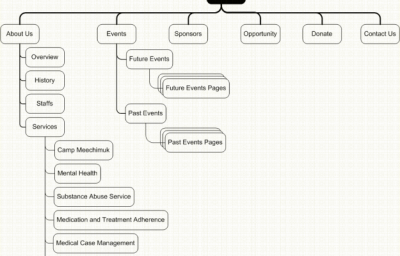
Fig. 1 Sitemap of the New Hispanos Unidos Website
Then, the team created a new design using a standard layout with a banner on top, a horizontal navigation menu, and the information displayed in the body with light gray background color while still being clear to read. Because the website uses the same template on all pages as opposed to one single long page, the users are able to navigate to sections of the site that interest them and feel more comfortable finding the information they are looking for (Duyne et al, 2007).
There are many free downloadable Content Management Systems available but many of them are overly complicated and require a certain level of technical expertise. The team determined that Hispanos Unidos did not need a highly sophisticated CMS. In addition to the basic web maintenance of text editing functionality, Hispanos Unidos needed a CMS that offered the following features: Blogs, Event Calendar, Google Maps, Photo Galleries, Secure File Sharing, Newsletter, Surveys, and Polls. Based on these requirements, the team selected five popular Content Management Systems, WordPress, Drupal, Joomla!, SilverStripe, and mojoPortal as candidates to carefully investigate. The team focused not only on simplicity and ease of use, but also on flexibility of features and customization. In the end, mojoPortal (http://www.mojoportal.com/) was selected as the CMS for the Hispanos Unidos website. mojoPortal provides an easy way to update the content and advertise the organization’s various events. For this project, mojoPortal version 2.3.5.1 on .Net 3.5 was used and the newly designed website was released in early 2011. New staff members’ information and pictures of the new events can now easily be uploaded and clearly displayed in a consistent size. The non-technical staff members at the organization can now handle any changes on their own using the CMS without needing an outside vendor. A well-written user manual provides detailed website maintenance instructions with snapshots. Several training sessions for staff members at Hispanos Unidos were also provided by students. Fig. 2 shows the home page of the original site and the newly designed site.
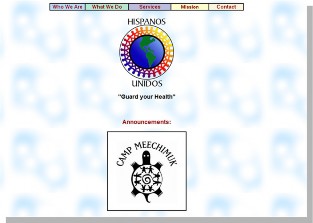
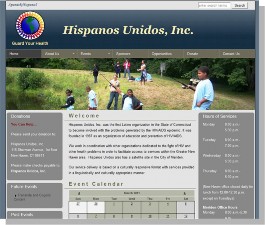
Fig. 2. Original Website (left) and Newly Design Hispanos Unidos Website (right)
Search engine optimization (SEO) was another important addition to the newly designed site. SEO is the process of improving the volume or quality of traffic to a website from search engines via natural or unpaid (organic or
algorithmic) search results (Enge & Spencer, 2012). To attract more visitors and make the site more visible to the community outside, some important search engine optimization measures were taken to the site: (1) adding meta tags of “keywords” including keywords from Google Analytics, “description”, and “title” on all individual pages, (2) directory submissions to search engines, (3) submitting XML sitemap to Google webmasters tool, etc.
After the development of the website, several research methods were used to assess the impact of this service learning project: (1) usability testing was conducted, (2) data from several surveys was collected in order to determine the improvements in the look of the website, and (3) statistical data using Google Analytics was collected and analyzed to measure the visibility of the site to the community.
Usability Testing Data
Usability is a measurement of effectiveness, efficiency, and satisfaction. In terms of web design, this means that websites are accurate, complete, comfortable to use, and acceptable to its users (Scowen and Regenbrecht, 2009). Jakob Nielsen broke usability up into five areas: learn-ability, efficiency, memorability, errors, and satisfaction (Nielsen and Loranger, 2006). Before the deployment of the newly designed Hispanos Unidos website to the public, a usability test was conducted asking ten randomly chosen people to rate the newly designed website on a scale of 0 (worst) to 5 (best) by answering ten questions in five categories: (1) the ease of learning the location of pages and how to access them, (2) the intuitiveness of the navigation compared to similar sites they had visited in the past, (3) the efficiency of the site including questions related to the ease of finding particular information on the site, (4) the memorability of the website, which measured how easily a user could find the same information on the website after coming back to it after one week, (5) the degree of satisfaction with the site overall including how visually pleasing it was and if they would visit the site again should they need information about the organization. The results show that the average rate, across all ten usability questions, was 4.5/5.0, demonstrating a high acceptance rate. The actual usability test questions and their average ratings are presented in Table 1.
Table 1.Usability Test Rating
|
Questions |
Average Rating |
|
You were able to locate different pages specified below easily |
4.5 |
|
You could access the pages easily |
4.8 |
|
The site was intuitive and easy to use |
4.8 |
|
You felt like the site made logical sense |
4.6 |
|
It was similar to other sites you have been to |
4.6 |
|
The site was efficient |
4.0 |
|
You didn’t have to wait a long time for the page to respond |
4.6 |
|
You could find the information again in a week |
4.4 |
|
You found the site visually pleasing |
4.2 |
|
You would revisit this site if you needed information about HU |
4.5 |
Survey Data
After the deployment of the newly designed website, survey data was collected from two user groups who were familiar with the original website and the newly-developed website. The “Administrator Survey” questionnaire was distributed to a group of staff and administrators of the organization and the “General Survey” was given to a voluntary group of regular users (customers) of the organization.
The Administrator Survey included more questions regarding the ease of updating the site through the CMS and the General Survey questioned the acceptance of the new design by users of the site focusing on the comparison of the new website to the old site. These ten questions were asked:
Q 1: Overall, how do you think the new site design compares to the previous one? Q2: Is the new design better organized?
Q3: Is the new design easier to read?
Q4: Do you find the experience on the new site more enjoyable? Q5: Does the new website load faster?
Q6: Rate your experience in finding the information you needed on the website. Q7: Please rate the usefulness of the website for Hispano Unidos Inc.
Q8: What do you like best about our new website? Q9: What do you like least about our new website?
Q10: What new features you want to see in our new website?
Overall, 67% of the participants responded “Big Improvement” and 32% responded “Improvement” as you can see from Figure 3. Not a single participant responded negatively to the changes in the website. Some criticisms from participants were content-related, not design-related. Several participants felt performance was an issue, but the users tested the site on a temporary site, not on the final server. The survey results are displayed in Fig. 3.
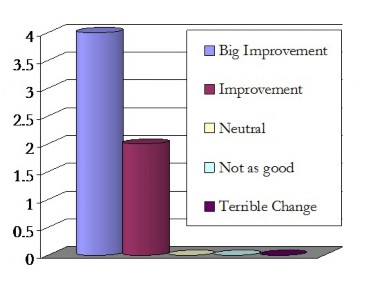
Fig. 3. User Experience Survey Results
The following are some comments collected from surveys:
“The Home page is very inviting. I like the photos. Layout is easy to navigate. Colors are appealing. Font is easy to read.”
“Everything looks good and clear to follow.”
“That it is more professional looking, well organized and easy to navigate.” “It’s warmer. The pictures are inviting. The tabs are easy to navigate to find information.”
“Overall visually more attractive.”
“The design, the layout, more life to website (i.e., the changing photos, etc.), the option to manage/edit, revise the website ourselves.”
Google Analytics Data
Google Analytics, offered by Google, is the most widely-used free website analytics service and provides detailed statistics about the visitors to a website (Google Analytics, 2011). Google Analytics is mainly used to measure the marketing effectiveness of the website (Moran and Hunt, 2009). A wide range of data can be collected including how many visitors come to the site, where they are coming from, how many new and returning visitors are on the site, and how users find this site. Google Analytics also shows the search keywords that were used to reach the website.
Google Analytics was added to the Hispanos Unidos website (http://www.hispanos-unidos.org) at the beginning of the Capstone Project course to provide a baseline and a point of comparison for the new site. Since then, Google Analytics data was collected to measure the changes by comparing the statistical data of the visitors to the original site to statistical data of the visitors to the newly designed site. We compared the data collected for the three- month time period of November 2010 to January 2011 from the original website to the data collected for the same three-month period of November 2011 to January 2012 from the new website after it was launched. Data collected showed significant improvement in the visibility of the site after launching the newly designed website, including a 40% increase in the number of unique visitors (the number of individual, non-duplicate visitors, to a site over the course of a specific time period), a 76% reduction in bounce rate (the percentage of visits in which the visitor only views one page of the website before leaving), and a 363% increase in the number of pages viewed. Details of the Google Analytics report are summarized in Table 2:
Table 2. Google Analytics Data Comparison
|
Metric |
Newly Designed Site (Nov 2011 to Feb 2012) |
Original Site (Nov 2010 to Feb 2011) |
Improvement |
|
Visitor Trending |
|||
|
Number of Visits |
633 |
472 |
34.11% |
|
Absolute Unique Visitors |
555 |
395 |
40.51% |
|
Visits / Day |
5.7 |
4.25 |
34.12% |
|
Average page views (Pages/Visit) |
6.57 |
1.9 |
245.79% |
|
Time on site (min) |
1.35 |
1.02 |
32.35% |
|
Traffic sources |
|||
|
Referring Sites+ (%) |
14.53 |
13.35 |
8.84% |
|
Via search Engines (%) |
73.46 |
69.07 |
6.36% |
|
Content Access |
|||
|
Page views |
4,156 |
897 |
363.32% |
|
Unique Page views |
1,354 |
711 |
90.44% |
|
Exit (%) |
15.23 |
52.62 |
-71.06% |
|
Bounce Rate (%) |
10.74 |
44.28 |
-75.75% |
+ Referring Sites: Other Websites that refer or send visitors to your Website
Additional charts comparing visitor trending (Fig. 4), the number of pages viewed (Fig. 5), and the bounce rate (i.e. the percentage of visitors who enter the site and bounce or leave the site rather than continue viewing other pages within the same site, Fig. 6) before and after the redesign are provided below:
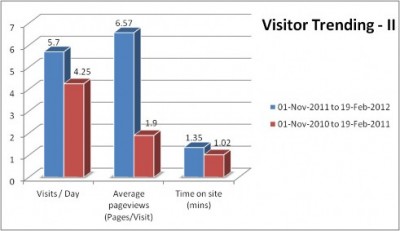
Fig. 4. Comparison of Visitor Trending
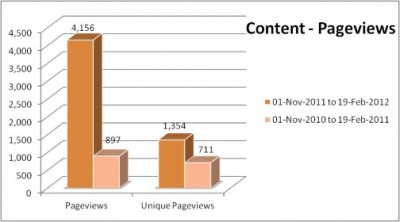
Fig. 5. Comparison of Pageviews
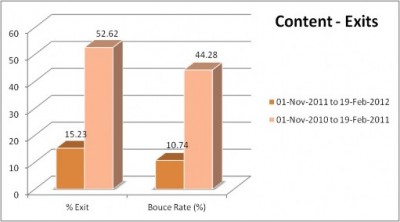
Fig. 6. Comparison of Number of Immediate Exits (bounce rate)
Significant improvement in the visibility of the website eventually led to higher exposure of Hispanidos Unidos in the community. In a survey of new members of Hispanos Unidos in May 2012, 52% of new members found the organization of Hispanos Unidos through an Internet search, significantly increased from 37% in 2011 survey before the new design of the website.
Lessons for Practitioners
Many non-technical organizations like Hispanos Unidos assume that once the website is developed and launched, the job is done. However, launching a website is just the start of a series of important maintenance tasks including content update, regular check-up on the website performance, and visitor interaction.
Updating the websites in a timely fashion is important in order to maintain the reputation of the organization (Friedlein, 2002). If websites are not well maintained, visitors may doubt the overall functionality of the organization and a well-maintained website could provide an edge over other similar organizations. Posting information of new events, contests, and gatherings on the website in a timely fashion can increase use of the website. Today, websites can be used for marketing and promotional purposes. Active and smart monitoring requires gathering data from websites such as the number of visitors, amount of traffic generated, etc. Analyzing the data and finding underlying traffic factors can help the organizations plan effectively for the future. However, the benefits of website monitoring are often overlooked by many non-technical organizations.
For easier website maintenance and visitor data collection, students in the Capstone Project course used a Content Management System (CMS) and provided a user manual and training to staff members. They also set up Google Analytics to the newly redesigned Hispanos Unidos website. However, unless the organization really understands the importance of maintenance and have organizational commitment, websites will easily become outdated. More importantly, the websites deployed are susceptible to being hacked, so regular software updates and information leakage prevention are critical to keep the website safe from potential security threats.
Website maintenance is a challenging task for many organizations and it is especially true for non-technical organizations that may lack the knowledge and tools needed for website upkeep. To deliver high-quality software products to service learning partners, we should think beyond website development and provide extra considerations to make the project sustainable. Through service learning projects, students learn the importance of software maintenance, which is another important benefit of service learning project to students set apart from other conventional industry projects in capstone project courses.
Conclusion and Future Directions
This article described how the software engineering service learning Capstone Project at Fairfield University helped Hispanos Unidos Inc. and showed the impact of this service learning project. The redesign of the Hispanos Unidos website was successfully completed by a group of students at Fairfield University and the data shows a high acceptance rate, high customer satisfaction over the old website, and higher traffic and loyalty to the newly designed website. This service learning project and its follow-up studies showed how software engineering projects could make significant contribution to the community. More data will be collected to measure the Capstone Project’s community impact after implementing the Spanish version of the website, the social media awareness feature, online donation feature, and more search engine optimization measures. We expect huge improvement in the Google Analytics data of visitors after the Spanish version is launched. We will also investigate more on how web presence helps the recognition of the organization in the community.
References
Adler-Kassner, L. (2000). Service-learning at a glance. Reflections on Community-Based Writing Instruction, 1, 28-29.
Boiko, Bob (2002). Content Management Bible. New York, NY: Wiley Publishing Inc. Duyne V., et al. (2007). The Design of Sites: Patterns for Creating Winning Websites.
Upper Saddle River, NJ: Prentice Hall.
Enge, E., Spencer, S., Stricchiola, J., & Fishkin, R. (2012). The Art of SEO.
2nd ed. Sebastopol, CA: O’Reilly Media.
Friedlein, Ashley (2002). Maintaining and Evolving Successful Commercial Websites.
San Francisco, CA: Morgan Kaufmann Publishing Inc.
Google Analytics (2011). In Official Google Website. Retrieved March, 9, 2011 from http://www.google.com/analytics page.
Hatcher, J. A. & Robert, G. B. (1997), Reflection: bridging the gap between service and learning, College Teaching Fall 1997 v45 n4 p153 (6).
Jacoby, B (2009), Civic Engagement in Higher Education: Concepts and Practices, Jossey-Bass.
mojoPortal.com. Self Hosting jQuery and jQuery UI files. Retrieved October 18, 2010, from Official Website: http://www.mojoportal.com/.
Moran, M., & Hunt, B. (2009). Search Engine Marketing, IBM Press, Michigan, pp. 199-335.
Nielsen, J., & Loranger, H. (2006). Prioritizing Web Usability, New Riders Press. Prajapati, B., Vo B., Motakoduru, S., & Nguyen T. (2010). Hispanos Unidos Website
Reengineering. Rep. Fairfield, CT: Fairfield University, Print.
Rusu, A., & Lawlor, J. (2010). Connecting Campus and Community through Web Development Service-Learning Projects, 40th ASEE/IEEE Frontiers in Education Conference, Washington, DC
Scowen, G., & Regenbrecht, H. (2009). Increased popularity through compliance with usability guidelines in E-learning websites, International Journal of Information Technology and Web Engineering.
About the author:
Wook-Sung Yoo
© 2012 Journal for Civic Commitment

